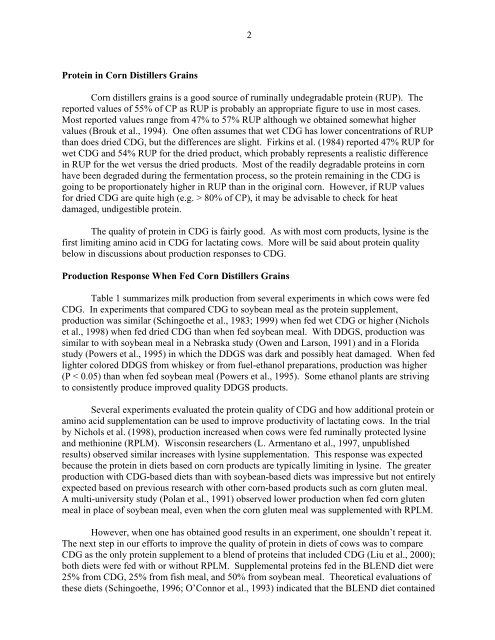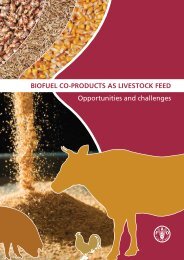Distillers Grains Feeding Recommendations. - Distillers Grains By ...
Distillers Grains Feeding Recommendations. - Distillers Grains By ...
Distillers Grains Feeding Recommendations. - Distillers Grains By ...
You also want an ePaper? Increase the reach of your titles
YUMPU automatically turns print PDFs into web optimized ePapers that Google loves.
2Protein in Corn <strong>Distillers</strong> <strong>Grains</strong>Corn distillers grains is a good source of ruminally undegradable protein (RUP). Thereported values of 55% of CP as RUP is probably an appropriate figure to use in most cases.Most reported values range from 47% to 57% RUP although we obtained somewhat highervalues (Brouk et al., 1994). One often assumes that wet CDG has lower concentrations of RUPthan does dried CDG, but the differences are slight. Firkins et al. (1984) reported 47% RUP forwet CDG and 54% RUP for the dried product, which probably represents a realistic differencein RUP for the wet versus the dried products. Most of the readily degradable proteins in cornhave been degraded during the fermentation process, so the protein remaining in the CDG isgoing to be proportionately higher in RUP than in the original corn. However, if RUP valuesfor dried CDG are quite high (e.g. > 80% of CP), it may be advisable to check for heatdamaged, undigestible protein.The quality of protein in CDG is fairly good. As with most corn products, lysine is thefirst limiting amino acid in CDG for lactating cows. More will be said about protein qualitybelow in discussions about production responses to CDG.Production Response When Fed Corn <strong>Distillers</strong> <strong>Grains</strong>Table 1 summarizes milk production from several experiments in which cows were fedCDG. In experiments that compared CDG to soybean meal as the protein supplement,production was similar (Schingoethe et al., 1983; 1999) when fed wet CDG or higher (Nicholset al., 1998) when fed dried CDG than when fed soybean meal. With DDGS, production wassimilar to with soybean meal in a Nebraska study (Owen and Larson, 1991) and in a Floridastudy (Powers et al., 1995) in which the DDGS was dark and possibly heat damaged. When fedlighter colored DDGS from whiskey or from fuel-ethanol preparations, production was higher(P < 0.05) than when fed soybean meal (Powers et al., 1995). Some ethanol plants are strivingto consistently produce improved quality DDGS products.Several experiments evaluated the protein quality of CDG and how additional protein oramino acid supplementation can be used to improve productivity of lactating cows. In the trialby Nichols et al. (1998), production increased when cows were fed ruminally protected lysineand methionine (RPLM). Wisconsin researchers (L. Armentano et al., 1997, unpublishedresults) observed similar increases with lysine supplementation. This response was expectedbecause the protein in diets based on corn products are typically limiting in lysine. The greaterproduction with CDG-based diets than with soybean-based diets was impressive but not entirelyexpected based on previous research with other corn-based products such as corn gluten meal.A multi-university study (Polan et al., 1991) observed lower production when fed corn glutenmeal in place of soybean meal, even when the corn gluten meal was supplemented with RPLM.However, when one has obtained good results in an experiment, one shouldn’t repeat it.The next step in our efforts to improve the quality of protein in diets of cows was to compareCDG as the only protein supplement to a blend of proteins that included CDG (Liu et al., 2000);both diets were fed with or without RPLM. Supplemental proteins fed in the BLEND diet were25% from CDG, 25% from fish meal, and 50% from soybean meal. Theoretical evaluations ofthese diets (Schingoethe, 1996; O’Connor et al., 1993) indicated that the BLEND diet contained
















